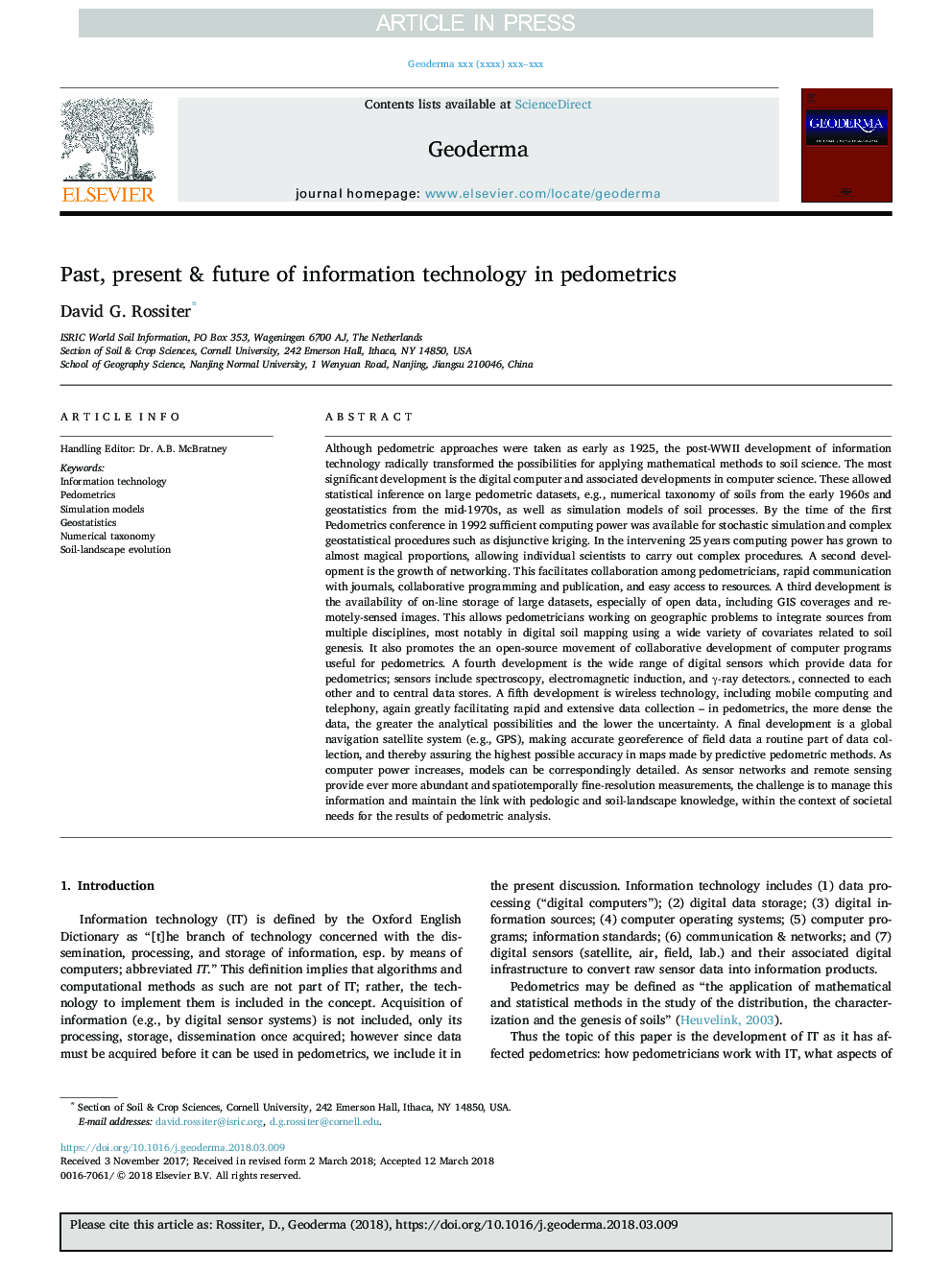| کد مقاله | کد نشریه | سال انتشار | مقاله انگلیسی | نسخه تمام متن |
|---|---|---|---|---|
| 8894049 | 1629393 | 2018 | 7 صفحه PDF | دانلود رایگان |
عنوان انگلیسی مقاله ISI
Past, present & future of information technology in pedometrics
دانلود مقاله + سفارش ترجمه
دانلود مقاله ISI انگلیسی
رایگان برای ایرانیان
کلمات کلیدی
موضوعات مرتبط
مهندسی و علوم پایه
علوم زمین و سیارات
فرآیندهای سطح زمین
پیش نمایش صفحه اول مقاله

چکیده انگلیسی
Although pedometric approaches were taken as early as 1925, the post-WWII development of information technology radically transformed the possibilities for applying mathematical methods to soil science. The most significant development is the digital computer and associated developments in computer science. These allowed statistical inference on large pedometric datasets, e.g., numerical taxonomy of soils from the early 1960s and geostatistics from the mid-1970s, as well as simulation models of soil processes. By the time of the first Pedometrics conference in 1992 sufficient computing power was available for stochastic simulation and complex geostatistical procedures such as disjunctive kriging. In the intervening 25â¯years computing power has grown to almost magical proportions, allowing individual scientists to carry out complex procedures. A second development is the growth of networking. This facilitates collaboration among pedometricians, rapid communication with journals, collaborative programming and publication, and easy access to resources. A third development is the availability of on-line storage of large datasets, especially of open data, including GIS coverages and remotely-sensed images. This allows pedometricians working on geographic problems to integrate sources from multiple disciplines, most notably in digital soil mapping using a wide variety of covariates related to soil genesis. It also promotes the an open-source movement of collaborative development of computer programs useful for pedometrics. A fourth development is the wide range of digital sensors which provide data for pedometrics; sensors include spectroscopy, electromagnetic induction, and γ-ray detectors., connected to each other and to central data stores. A fifth development is wireless technology, including mobile computing and telephony, again greatly facilitating rapid and extensive data collection - in pedometrics, the more dense the data, the greater the analytical possibilities and the lower the uncertainty. A final development is a global navigation satellite system (e.g., GPS), making accurate georeference of field data a routine part of data collection, and thereby assuring the highest possible accuracy in maps made by predictive pedometric methods. As computer power increases, models can be correspondingly detailed. As sensor networks and remote sensing provide ever more abundant and spatiotemporally fine-resolution measurements, the challenge is to manage this information and maintain the link with pedologic and soil-landscape knowledge, within the context of societal needs for the results of pedometric analysis.
ناشر
Database: Elsevier - ScienceDirect (ساینس دایرکت)
Journal: Geoderma - Volume 324, 15 August 2018, Pages 131-137
Journal: Geoderma - Volume 324, 15 August 2018, Pages 131-137
نویسندگان
David G. Rossiter,